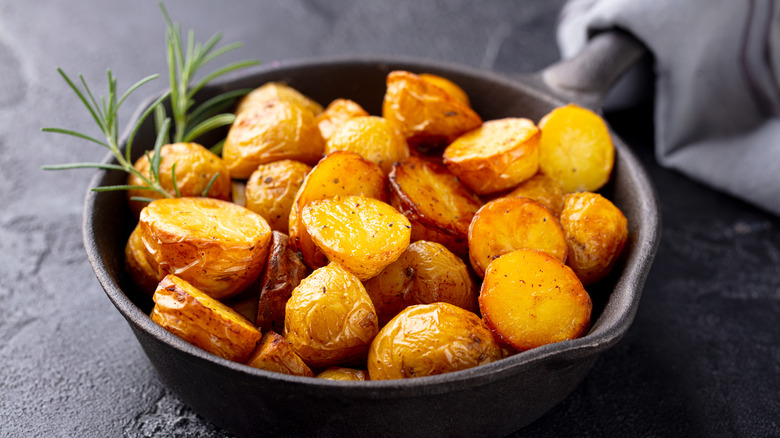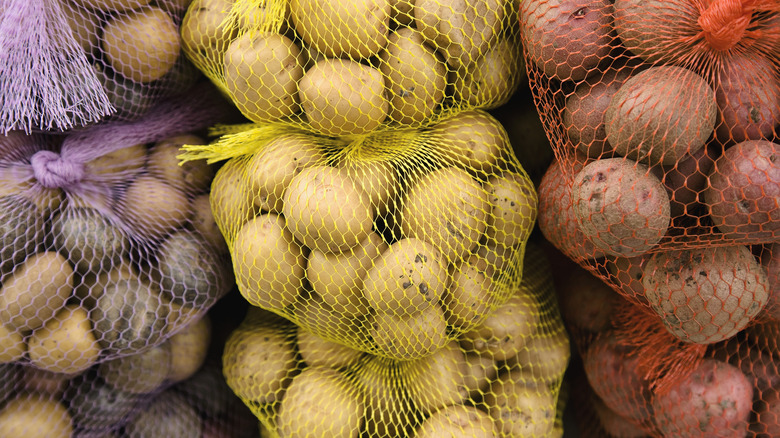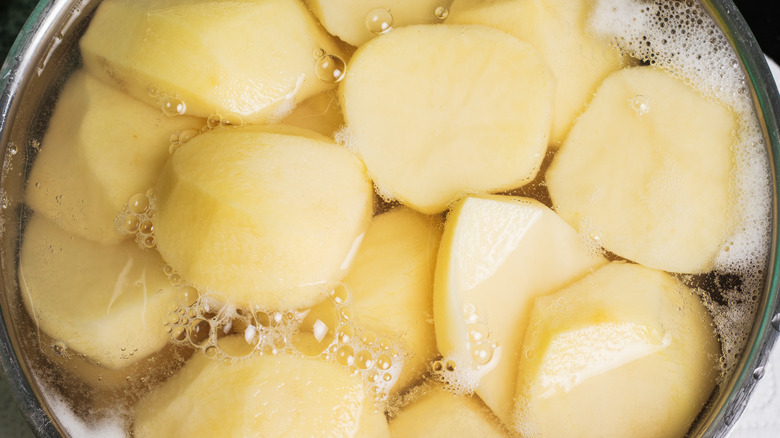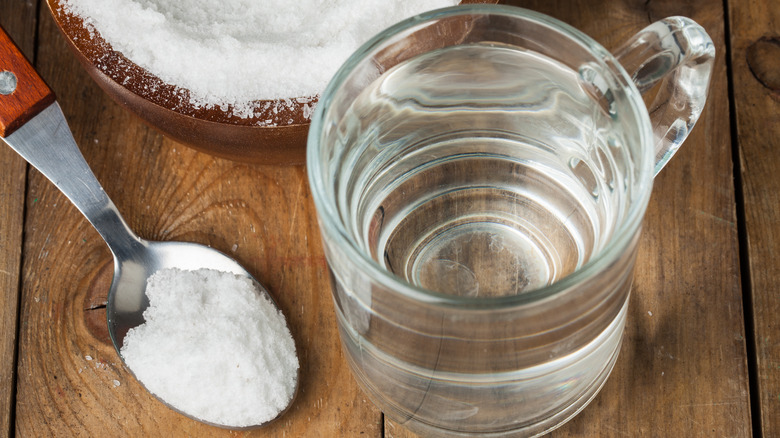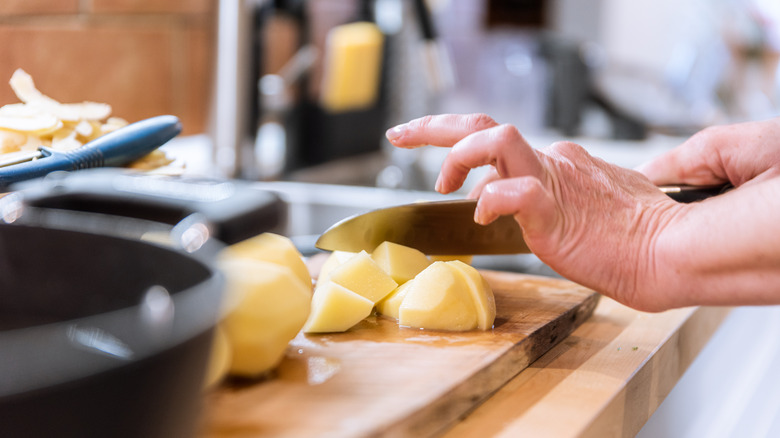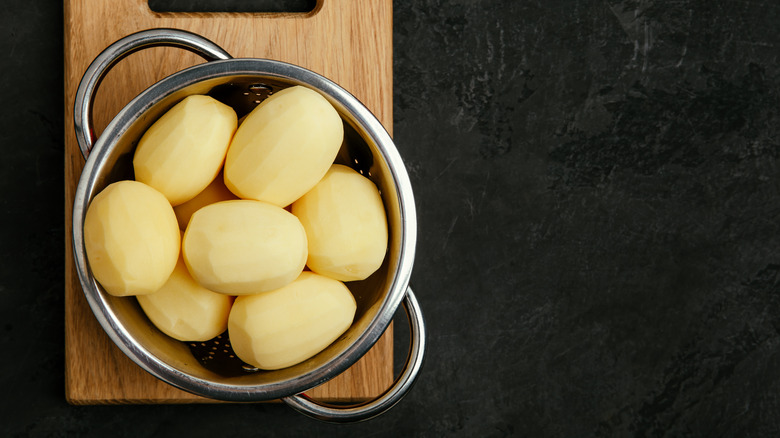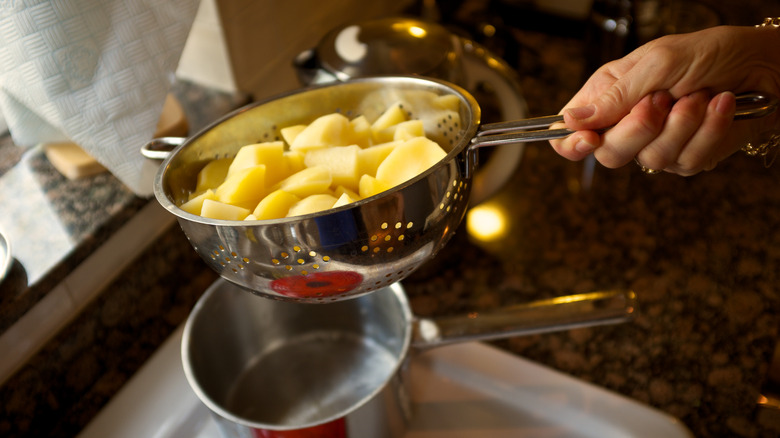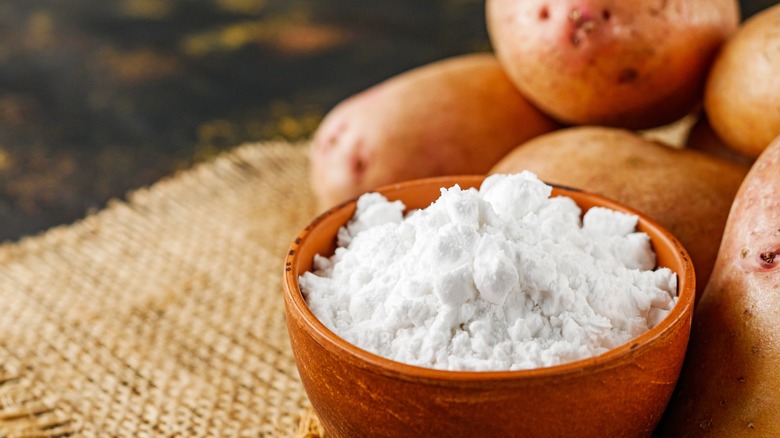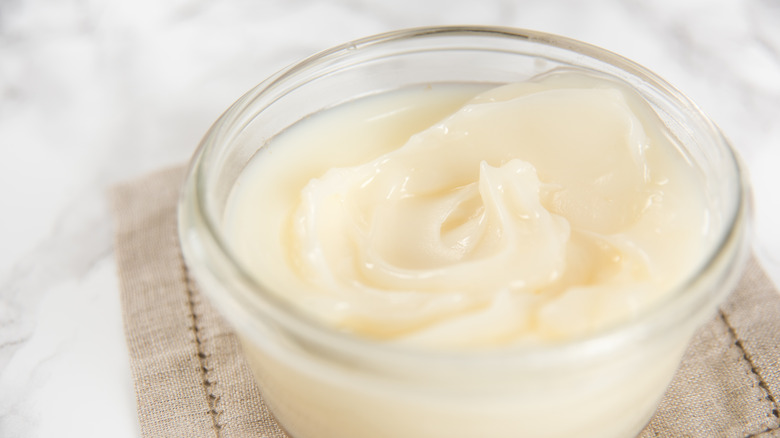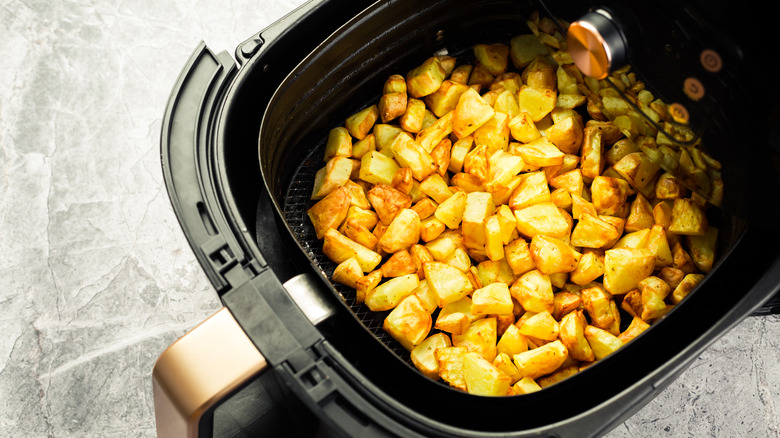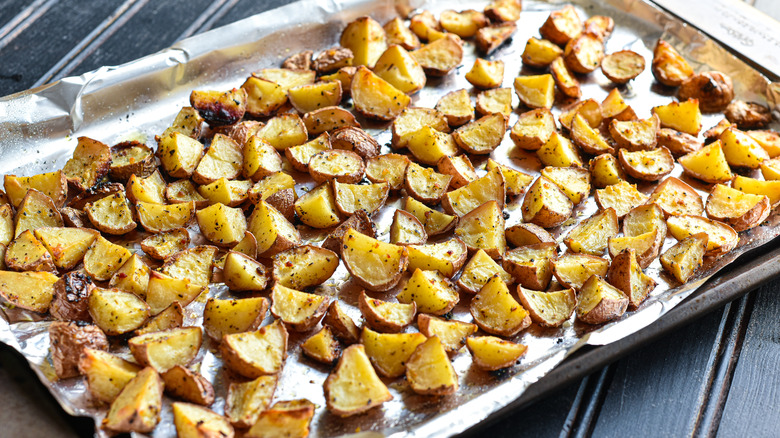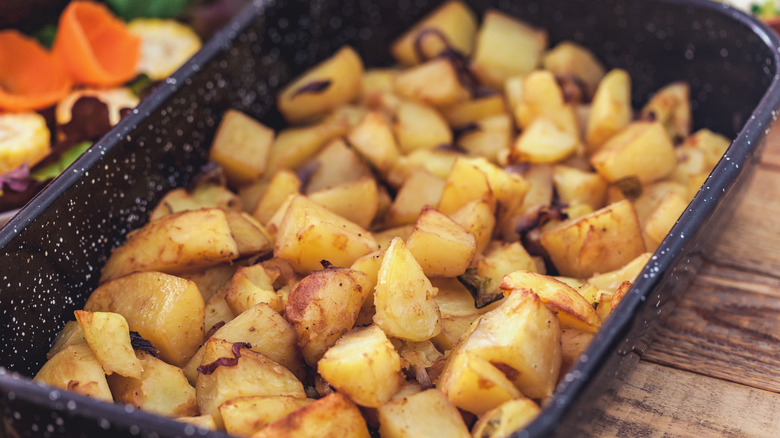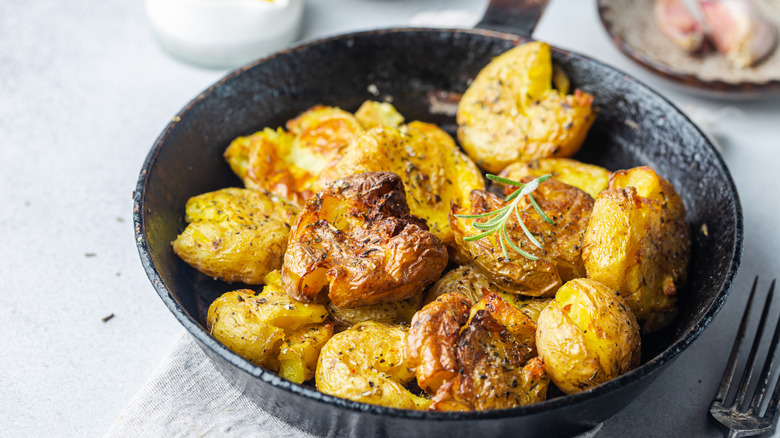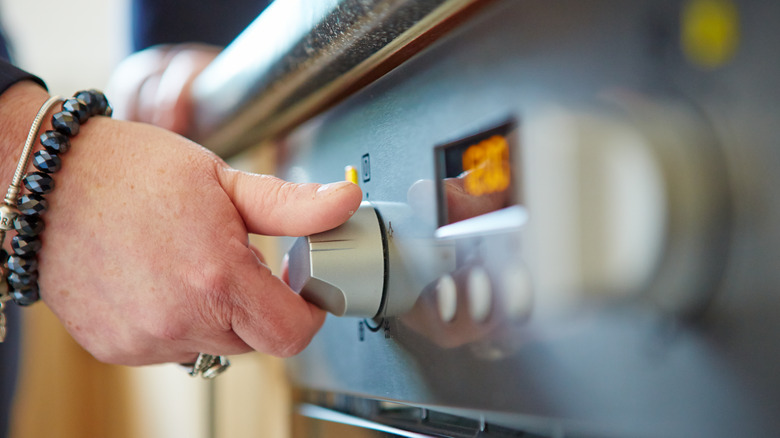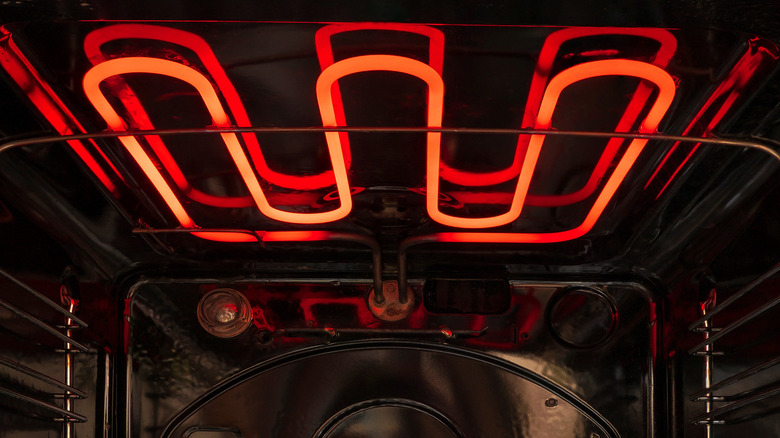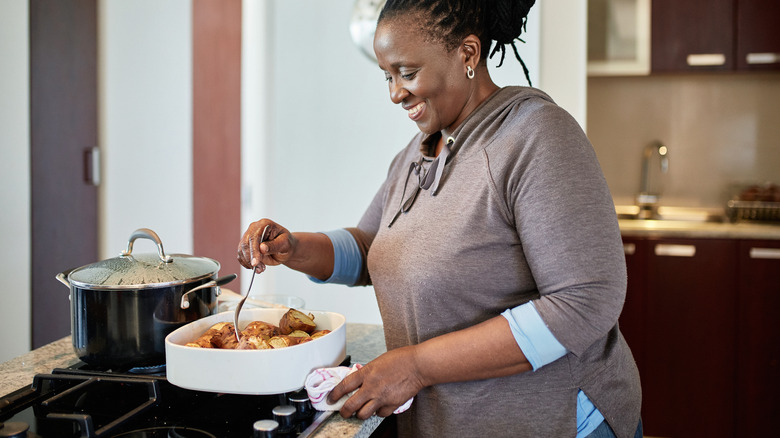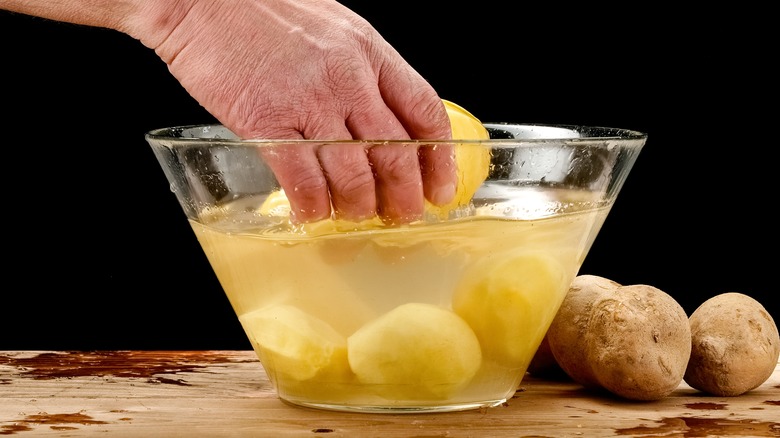16 Tricks To Make Potatoes Extra Crispy
There are few culinary disappointments more heartbreaking than biting into what one assumes will be a crunchy, crispy potato and finding it to be chewy or tough. While I can't claim that my restaurant management career and countless hours spent behind the stove have been the result of a personal oath to prevent anyone experiencing this disappointment ever again, my experience has certainly taught me a few things I didn't know about potatoes.
Of course, I also picked up a trick (or 16) on how to make potatoes extra crispy, including picking the best spuds for the job, professional-level prep work, culinary hacks, and the best cooking techniques. The following advice is the culmination of experience ranging from slinging Sunday roasts in British pubs to silver-serving fondant potatoes in fine-dining establishments. So tuck into the tips below and you'll soon be producing nothing but the crispiest, tastiest potatoes you've ever tasted.
Choosing the right type of potato
Before we start looking at specific cooking tips, we need to think about what type of potato we're using when extra crispiness is our ultimate goal. Given that there are over 5,000 varieties in existence, it stands to reason that different types of potatoes belong in different dishes.
To simplify matters, it's best to think of potatoes existing on a spectrum that ranges from waxy to starchy. Waxy potatoes tend to have smoother, thinner skin and a creamier texture that makes them the prime pick for boiling and steaming. Starchy potatoes, on the other hand, are fluffier with less moisture inside and are ideal for roasting, frying, and mashing. You'll find plenty of all-purpose varieties that are considerably versatile, but for extra crispy potatoes, we want to aim towards the starchy end of the scale. In my experience, russets are the way to go for a golden crisp exterior with a deliciously light interior, but you'll find the Idahos and Yukon Golds are also more than up for the task.
Parboil potatoes before cooking
If you've ever baked a potato before, you'll know that it takes a long time for the inside to cook fully — often up to an hour for a decent sized spud. This can present problems when we're trying to get the outside nice and crispy with a high heat. The issue is that by the time the exterior hits our desired level of crispiness, the inside of the potato is a ways off from being done, meaning it'll be hard and unappealing at best, and still raw at worst.
Fortunately, the solution is simple. By parboiling — a portmanteau of partial boiling — we can give the interior of the potatoes a head start on the cooking process. The key is to start with your peeled potatoes in a saucepan of cold, salted water, as this will help them cook evenly and prevent the exteriors from becoming over-cooked and sticking together. Once the water begins to boil, turn down the heat and let the potatoes simmer until the insides are tender enough to push a fork into without them falling apart.
Choose an alkaline water for boiling
Recently, there's been a bit of buzz surrounding alkaline water as a healthier alternative to regular drinking water. Now, while there's not enough research to suggest this is more than just a fad, alkaline water can come in handy when we're trying to get our potatoes as crispy as possible.
In simple terms, alkaline water is just less acidic than standard tap water with a lower pH level, and this helps to break down the surface of the potato as it boils. This extra degradation aids in the formation of starchy flakes which increases the surface area of the potato, one of the keys to crispiness. Before you start considering whether it's worth splashing out on those pricey bottles of alkaline water just for boiling your potatoes, you should know that it's completely unnecessary to do so. Simply add a little baking soda to the tap water in your pot, about a ¼ teaspoon for every quart, and you'll bring down the pH enough to do the job.
Make your potato pieces the same size
We've already established that producing something with a crispy outside and a fluffy inside takes a little extra work, and one of the most important factors isn't even in the cooking. To guarantee every bite is consistent, it's crucial that each piece of potato is as uniformly sized as possible.
The actual size you go with isn't too much of an issue, just that it's consistent throughout; although, how big or small you make the pieces will impact the cooking times and final outcome. Smaller pieces won't need parboiling for as long and will have a similar texture throughout. Larger pieces will offer a much more interesting contrast between the crispy shell and the soft middle, and parboiling is essential to make sure they're cooked all the way through. Either is fine, but if you have a combination of sizes, you're going to have to choose between having the smaller pieces overdone or the larger pieces undercooked.
Dry your potatoes thoroughly
After parboiling, it's essential to remove as much moisture as possible from your potato pieces. If there's still water present when we transfer them to high and dry heat, it's going to turn into steam. If there's too much steam present on the surface of the potatoes, they will struggle to crisp up, and you're more likely to end up with a disappointingly soggy exterior.
Drying spuds is easy enough — first, you'll want to use a colander over the sink to drain off the majority of the water. Then, you can use kitchen towels to pat the potato pieces dry. Paper towels are the best choice, as they're the most effective at absorbing the excess water; just try not to skimp too much on quality. If the paper is too weak or thin, it's likely to come apart and stick to the potato, and you might end up with pieces of the towel cooked into the exterior.
Give the potatoes a sieve shakedown
As a Brit, there are few dishes as iconic as the Sunday roast dinner. A roast without crispy potatoes is sacrilege, which is why we've been using this next trick to great effect since any of us can remember.
We've already touched upon how the key to crispy potatoes is increasing the surface area of the pieces: This is so the exterior can absorb more fat which in turn enhances the crispiness. Once the potatoes have been parboiled, we then rough them up a bit. You can do this by putting the pieces into a dry saucepan and using a wooden spoon to stir them around, but there's a better tool for the job. Pop your dry potatoes into a sieve or colander — preferably one made of metal — and give them a good old shakedown. This will finely grate the outsides of the potatoes and create a rough surface that will crisp up much better than a smooth one.
Try adding a high-starch flour
Once your potatoes are as dry as possible, there's one more ingredient you can add to give them a thicker, crunchier coating. While you're shaking them to rough up the edges, try sprinkling on a little flour.
The type of flour you add should be a high-starch variety in order to be effective, so avoid using the regular all-purpose stuff. Semolina, a coarse durum wheat flour, is ideal for giving your spuds an extra crispy texture. Cornstarch and potato flour are also highly effective if you can't get your hands on semolina. Not only does the flour help absorb excess moisture, but the extra starch will gelatinize and crisp up when heated. Your potatoes will brown up better, and the flour will help dry seasonings stick to the outer surface during cooking. You don't need to dredge the potatoes as if you're breading them; 1 tablespoon of flour per 2 pounds of potatoes should be enough to do the trick.
Don't forget the fat
If you're aiming to make the crispiest potatoes, you won't get anywhere without thinking about your fat. There are a few different options to choose from depending on your flavor preferences, with some being easier than others.
The simplest fat to use is oil, and while there are plenty of different cooking oils you can try, your best bet is to stick to the basics that won't imbue your potatoes with flavors that don't match up. Olive oil is a solid pick but be wary of its smoke point; if you're cooking at higher temperatures, you might want to opt for vegetable oil instead. However, for the crispiest potatoes with a subtle savory flavor boost, goose or duck fat are excellent choices — the former being slightly gamier and more intense and the latter being mellower and slightly sweeter. If you really want to go all out, try using the confit method — meaning to slow cook in fat — by combining garlic and rosemary in beef tallow and using it to roast your potatoes until they're golden brown.
Invest in an air fryer
If you're yet to jump on the air fryer hype, the fact that they can churn out gloriously crispy potatoes with ease is as good a reason as any to buy one. While they're not the cheapest bit of kitchen kit, with a decent unit costing up to a couple hundred dollars, they're truly a culinary game-changer.
Air fryers use a high-temperature heating element and powerful fan to circulate heat around the food inside the fryer basket. The result is food that you'd think had been deep fried but with a fraction of the oil or fat. As long as you avoid the common air fryer mistake of overdoing it on the dry seasonings, the appliance is the perfect way to crisp up potatoes while keeping them lighter and lower in saturated fat. An air fryer will also significantly cut down cooking times; it takes as little as 20 minutes to cook a batch of spuds to perfection.
Don't overcrowd the potato pieces
However you decide to cook your potatoes, overcrowding the baking dish, frying pan, or air fryer basket is going to reduce their crispy potential. The first issue you might face is having the pieces become stuck together as they cook, making them more likely to fall apart when you try to separate them.
Overcrowding also restricts airflow, so the potatoes aren't going to cook uniformly throughout or crisp evenly on the surface. This can leave you with uncooked centers or soft patches on the outsides. If you need to cook large batches of potatoes, your best bet is to use an oven to roast them and double up on the baking trays. Just make sure to swap the tray positions halfway through to ensure all of the potato pieces are evenly cooked and have the chance to crisp up under the direct heat of the oven element.
Remember to give your potatoes a flip
While you don't want to open your oven too often and cause heat to escape, you'll want to do it one time to flip your potatoes halfway through the cooking time. Unless you're using a rack, one side of each potato piece is going to be in contact with the base of the pan, which means it's less likely to get the right amount of direct heat exposure.
In some cases, the unexposed side might end up undercooked without the chance to get crispy enough. On the other hand, if your pan is extra hot, the unexposed side might end up burnt and may even stick to the base of the dish. Flipping your potatoes prevents either of these scenarios from happening, as every part of the surface gets a chance to crisp up properly without overcooking. It's also a good opportunity to stir your potatoes and redistribute the fat to ensure an even coating, and you might even want to baste them if there's excess fat or oil in the pan.
Try the smash and fry method
Out of all the crispy potato recipes I've tried, my personal favorite is the smash-and-fry method. It's relatively quick and extremely simple, and I've yet to find a better method for getting the optimum crust on a spud.
For starters, you'll want a potato variety that's relatively small and falls somewhere in the middle of the starchy/waxy scale, like the aforementioned Yukon Golds. Parboil them until you can insert a fork all the way through with some resistance, drain and dry them, then use a potato masher or the flat of a kitchen knife to lightly squash them until they're about ½ inch thick. Melt some butter in a frying pan with olive oil, sliced garlic, and a few sprigs of rosemary. Fry your smashed potatoes at medium heat for around 20 minutes, flipping them halfway through and seasoning them with salt and pepper. Et voilà — decadently crispy, bite-sized potatoes that you won't be able to get enough of.
Preheat your oven
One of the most common culinary mistakes people make is failing to preheat their oven before they put their food in it to cook. Not only does preheating ensure even cooking and accurate timing, but it's crucial if you're after oven-made crispy, golden brown potatoes.
Part of what makes crispy potatoes so tasty is something called the Maillard reaction. This is the chemical process that, in simple terms, caramelizes sugars and starches on the surface of food and is responsible for the rich flavors we associate with roasted dishes. Preheating your oven helps to kickstart the Maillard reaction as soon as you get your food inside, and it gives you a far better chance of achieving the complex flavors and crispy coating you're looking for. If you skip this step, there's a much higher chance that some of your potatoes will be undercooked, and you can kiss textural perfection goodbye.
Finish the potatoes under the broiler
If you're managing to get the insides of your potatoes just the way you like them yet you're struggling to get the exterior crispiness just right, your oven likely has an oft overlooked feature that holds the answer. Most modern ovens have a broiler, and it's the number one way to boost crispiness after your food is done cooking.
A broiler is simply a heating element at the top of the oven that applies intense, direct heat to the food you place beneath it. There are a few common mistakes first-timers make when cooking with a broiler, but if you know how to avoid these, it will become an invaluable tool in your culinary arsenal. Once your potatoes are cooked on the inside, you can switch your oven to the broiler setting and raise the pan up to a higher rack so it's closer to the heat source. Make sure to keep a close eye on your potatoes as broilers work their magic quickly, and you'll find it takes very little time to boost the browning on their surface and crisp up the exterior texture.
Serve the potatoes as soon as possible
While some foods, especially meats, benefit from being allowed to rest a while before being served, the same can't be said for potatoes. Once they've finished cooking, you'll want to serve your potatoes quickly if you want them to remain nice and crispy. As the potato pieces begin to cool, they begin to absorb moisture, and the steam inside begins to escape and condense on the surface, turning the outsides from crunchy and flavorsome to soggy and unappealing.
That being said, if you've cooked your potatoes thoroughly and managed to attain peak crispiness, the outer surface will trap heat inside. Taking a bite straight away is likely to result in a burnt mouth, so you may want to prick the potato pieces with a fork to allow some of the heat to escape. At the very least, you should cut your potatoes up a little before tucking in.
Soak your potatoes in ice water
Finally, if your potato pieces are small enough that they don't require parboiling, there's another technique that's worth trying out. The ice water hack for ultra-crispy roast potatoes will increase your prep time, but it's well worth the additional effort.
Once you've chopped your potatoes up into bite-sized pieces, toss them into a bowl of ice water and leave them to soak for a couple of hours. The cold water will draw the starches in the potato to the surface which will help them cook more evenly. It'll also cool down the potato pieces so that the insides take a little longer to cook than the outsides, creating a better textural contrast between the crispy skin and the fluffy center. As long as the potato slices are fully submerged in the water, they'll also be protected from oxidation. This means you don't have to worry about them turning that unappealing shade of brown that's common with peeled potatoes that have been left out too long before cooking.

